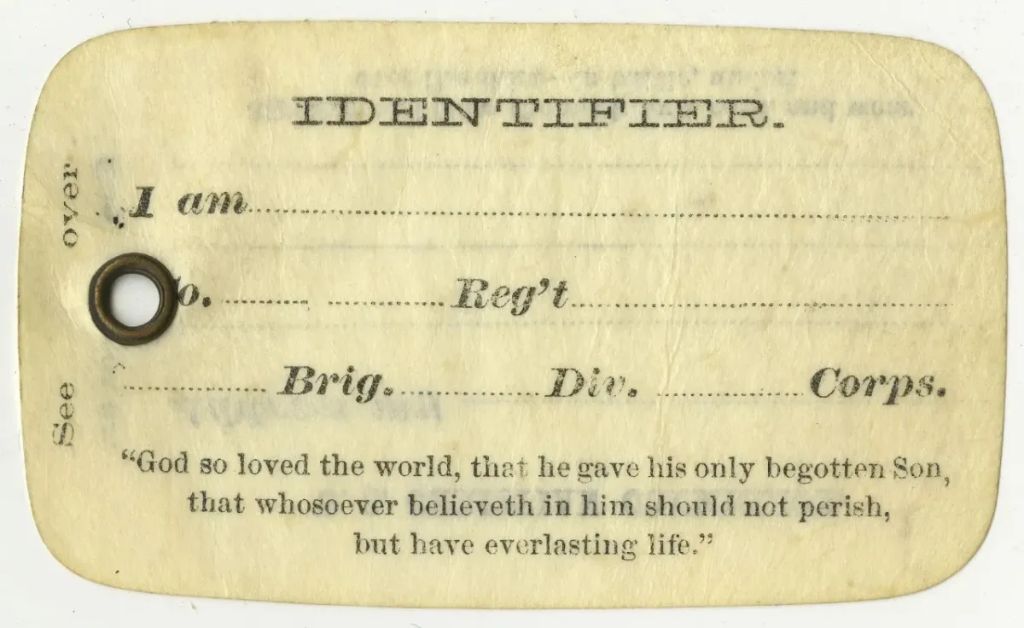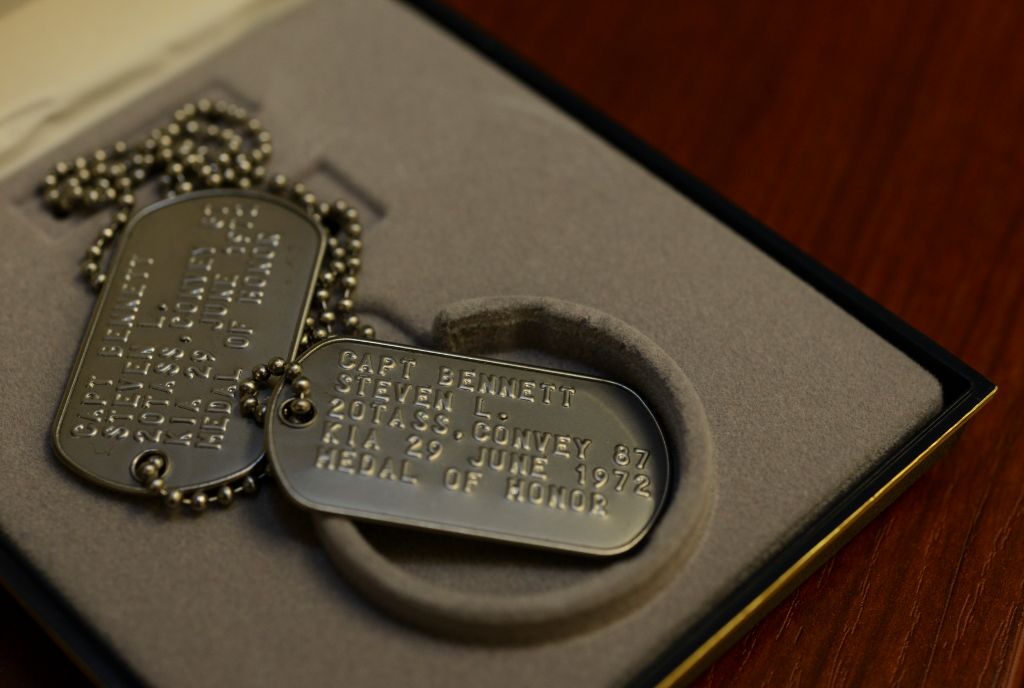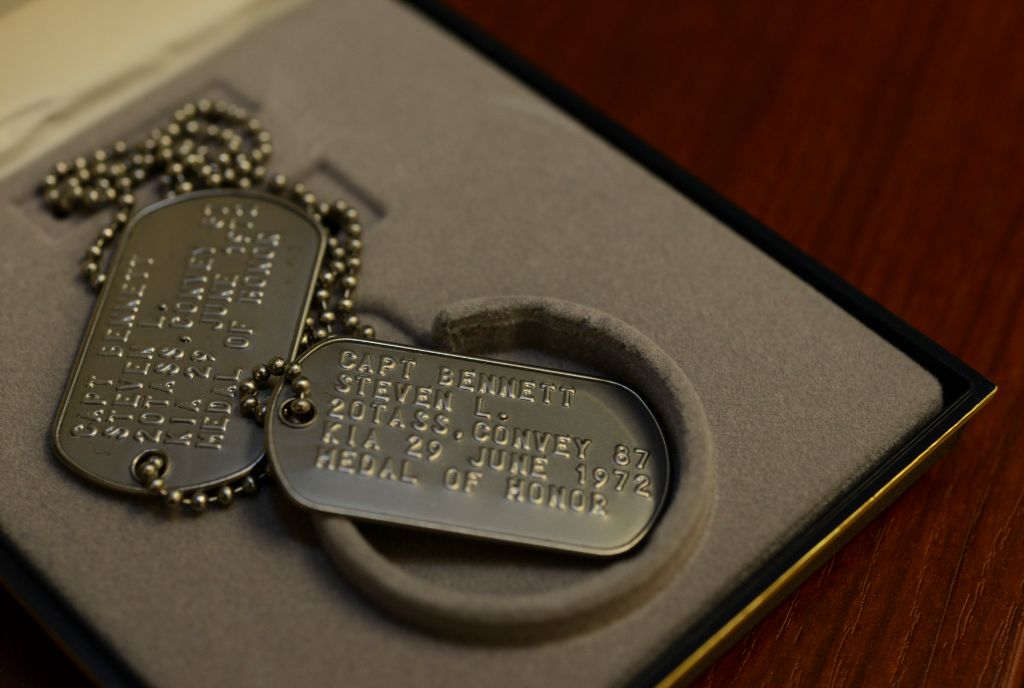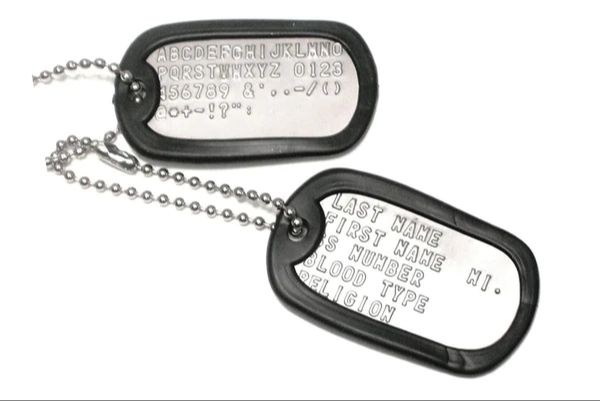Introduction
Dog tags are identification tags worn by military personnel. They typically contain basic personal information like the soldier’s name, rank, service number, blood type, and religious affiliation. The use of identification tags for soldiers dates back to the Roman Empire, but they did not become standard issue for American troops until the early 20th century. During World War I, identification tags became known as “dog tags” by U.S. soldiers – some say due to their resemblance to actual dog collars. Since then, dog tags have become an iconic part of military service and culture. They help ensure proper identification and handling of remains on the battlefield.
What Are Dog Tags?
Dog tags are small metal plates worn on a chain around the neck that are used to identify soldiers. The tags typically contain basic personal information about the soldier, such as name, rank, service number, and blood type. The purpose of dog tags is to quickly provide critical identification details about a service member, especially if they become injured or killed in action.
The term “dog tags” comes from the tags resemblance to actual dog collars worn by pets. The size, shape, and wearing style of military dog tags mirrors identification tags worn by dogs. According to the U.S. Army Quartermaster Museum, the tags were informally called “dog tags” by WWII soldiers because of this similarity. The name stuck even though they are formally known as identification tags.
Dog tags usually come in pairs and are made of a durable metal such as stainless steel or titanium. They are between 2-2.5 inches long and 0.5 inches wide. The standard tags are oval-shaped with rounded edges and contain stamped indentations with the identification details. One tag is meant to stay with the body while the other is collected for record keeping purposes. The chain allows the tag to be worn under clothing but accessible if needed.
Sources:
https://usquicktags.com/blogs/usquickblogs/why-are-they-called-dog-tags-in-the-military
https://www.mydogtag.com/military/army-dog-tags
Origins of Dog Tags
The origins of dog tags can be traced back to the Civil War era in the 1860s. During the war, dead soldiers were difficult to identify due to the heavy casualties. To address this, some soldiers began writing their names and home addresses on pieces of paper that they pinned to their uniforms. However, paper was not very durable, especially on the battlefield. This led to the idea of writing identification information on durable metal tags that could be worn by each soldier.
According to the Medals of America military blog, the first metal identification tags were issued to Union Army soldiers in 1862. These tags were circular discs with a hole punch at the top so they could be worn around the neck on a string or chain. The soldier’s name, rank, company, and regiment were stamped or engraved into the disc. Some tags also included address information. The Union Army required all of its soldiers to wear identification tags to help keep track of casualties.
The Confederate Army did not issue metal identification tags to its troops during the Civil War. However, some Confederate soldiers did make their own handmade identification tags out of scrap metal. The use of identification tags for soldiers soon spread to other militaries around the world after the Civil War. By the early 20th century, many militaries were issuing metal dog tags to troops as standard practice.

When Did Dog Tags Become Standard Issue?
Though identification tags were used by some soldiers in the late 1800s, they did not become standard issue in the United States military until 1906. According to the U.S. Army’s official history[1], War Department General Order No. 204, dated December 20, 1906, first authorized identification tags for all U.S. Army enlisted personnel. This order stated that the tags would be “furnished to each enlisted man as soon as practicable.”
The tags were meant to provide crucial identifying information in case a soldier became a casualty on the battlefield. Despite this order, dog tags were not consistently issued to soldiers until around World War I. By the time World War II began, dog tags had become standard issue across all branches of the U.S. military.
What Information Do Dog Tags Contain?
Modern military dog tags contain several pieces of key identifying information about the service member they belong to. This includes the service member’s full name, social security number, blood type, and religious preference.

Specifically, today’s dog tags list the service member’s first name, middle initial, and last name. They also contain the service member’s branch of service, followed by their social security number. The tags indicate the service member’s blood type (A, B, AB, or O) and their Rh factor (positive or negative). Finally, the tags note the individual’s religious preference, if any.
Previous iterations of military dog tags throughout history contained similar but slightly different information. For example, during World War II, dog tags listed the service member’s name, rank, serial number, blood type, and religious denomination according to sources. So while some details have evolved, name, identifying numbers, blood type, and religion have remained consistent key pieces of information on dog tags over time.
Who Gets Issued Dog Tags?
Dog tags are standard issue for active duty military personnel in the Army, Navy, Air Force, Marines, and Coast Guard (1). This means that any enlisted service member or officer who is serving full-time will be issued dog tags upon entering basic training or officer training.
Not every member of the military will receive dog tags, however. Military reservists and National Guard members typically only get dog tags when they are activated or deployed (2). Likewise, military veterans who have been discharged usually turn in their dog tags upon separation.
Though dog tags are intended for identification purposes in the event of death, not all military roles come with equal risk. As a result, support personnel like cooks, clerks, and mechanics may not rate dog tags. Soldiers in administrative, recruiting, or headquarters roles may also not receive dog tags (2).
Overall, dog tags are standard for most active duty service members in ground combat or hazardous duty positions. Support staff and those less likely to be killed in action may not qualify for issuance of dog tags.
Sources:
(1) https://www.ussjpkennedyjr.org/navy-sailors-issued-dog-tags-for-identification/
(2) https://www.reddit.com/r/GhostRecon/comments/bi2roz/operation_oracle_dog_tag/
Are There Exceptions?
While normally all soldiers are issued standard dog tags, there are some exceptions where a soldier may not receive dog tags or may receive specialty dog tags.
New recruits in basic training are often not issued dog tags until after they graduate. This prevents losing them during rigorous training. According to Why don’t soldiers wear their dog tags?, some soldiers may choose not to wear dog tags in non-combat situations since they are uncomfortable or can create noise that gives away position.
Soldiers in sensitive operations, like special forces units, may forego dog tags to protect their identities. Religious personnel receive specialty dog tags indicating their non-combatant status. There are also alternative identification methods, like wrist bands or “dog tag tablets”, that some soldiers can choose to use instead of standard dog tags.
Overall there are some exceptions, but the vast majority of soldiers are issued regulation dog tags as standard procedure. Specific missions, beliefs, or personal preference allow some soldiers to use alternatives to dog tags if needed.
Special Dog Tags

Beyond the standard-issue dog tags, there are special types of dog tags for military personnel with specific needs or preferences. Some examples include religious dog tags, medical alert dog tags, and stainless steel dog tags.[Etsy, “Special dog tags”](https://www.etsy.com/market/special_dog_tags)
Religious dog tags allow soldiers to identify their faith. These dog tags are engraved with symbols representing various religious affiliations like Christianity, Judaism, Islam, and others. Soldiers can wear religious dog tags along with standard identification tags.
Medical alert dog tags are designed for soldiers with medical conditions like diabetes, allergies, or blood type. These dog tags clearly indicate the medical information to inform medics in case of an emergency.
Stainless steel dog tags are popular alternatives to standard-issue metal dog tags. Stainless steel is highly durable and less prone to corrosion. Soldiers often prefer the look and feel of stainless steel dog tags.

During WWII, some specialty dog tags were made for soldiers in elite military units like parachutists, marksmen, and airborne divisions. These “specialist” dog tags designated the wearer’s unique skills and qualifications.[Med-Dept.com, “U.S. Army WW2 Dog Tags”](https://www.med-dept.com/articles/u-s-army-ww2-dog-tags/)
Dog Tag Alternatives
While dog tags are standard issue for most soldiers, there are some alternatives that can be used for identification purposes. Some of these include:
Silicone Wristband Tags: Many soldiers opt for silicone wristbands with engraved info instead of metal dog tags. They are more comfortable and eliminate noise. Companies like Dog Tags Uk offer custom silicone wristband tags.
PVC Wristband Tags: PVC wristband tags are another popular alternative. They are more durable than silicone but still eliminate noise. Engraving info on PVC tags is an option.
QR Code Tags: QR code identification tags contain a scannable QR code that links to the soldier’s digital records. This allows quick access to info without physical engraving.
Chest Harness ID: Some soldiers use chest harnesses with velcro ID patches containing basic personal info. These provide identification without metal tags.
Tattoo ID Markings: Although not common, some soldiers get identification info tattooed instead of wearing metal dog tags. This provides indelible identification marks.
While dog tags are standard, these alternatives provide soldiers with additional identification options that may better suit their needs and preferences.
Conclusion
In summary, military identification dog tags have a long history dating back to the Civil War when soldiers began informally making their own identification tags. They became standard issue for U.S. soldiers during World War II in order to quickly identify the wounded or killed in combat. Today, dog tags contain vital information about a soldier and are issued to nearly every member of the armed forces. They serve as an iconic symbol of military service. While styles and materials have evolved over the years, dog tags remain an essential part of a soldier’s gear and an important means of identification.
